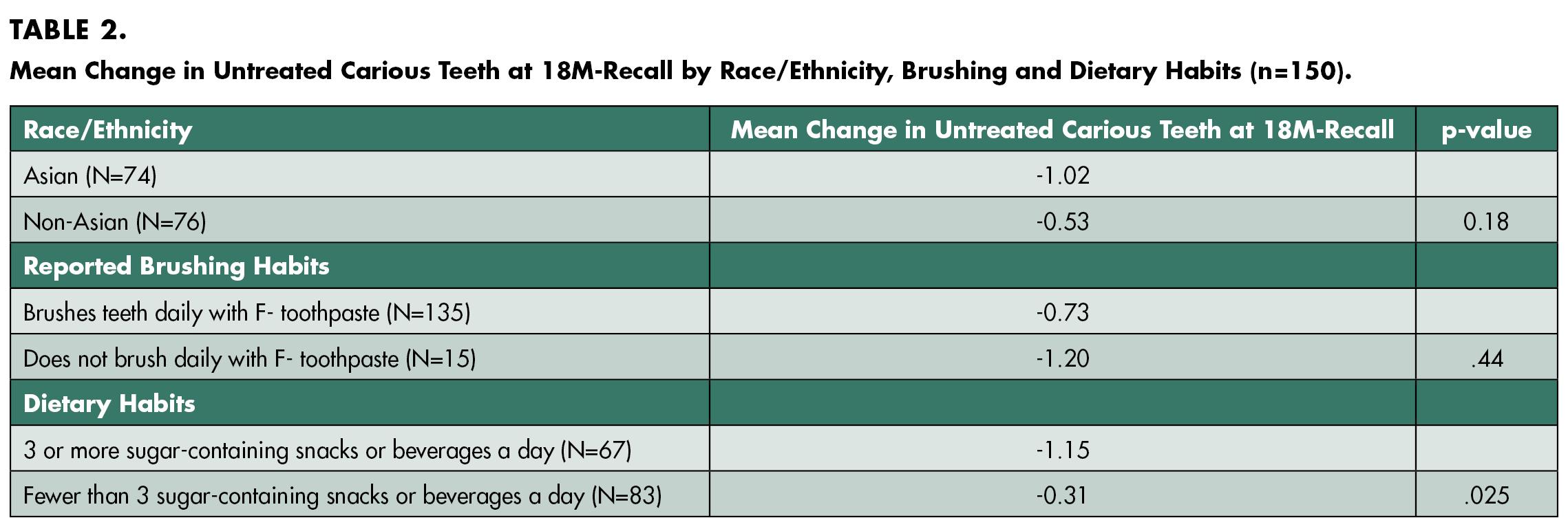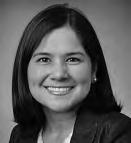
11 minute read
Comparison of Untreated Caries and CariesRisk Improvement in an Elementary-SchoolBased Comprehensive Dental Care Program
Comparison of Untreated Caries and CariesRisk Improvement in an Elementary-SchoolBased Comprehensive Dental Care Program
John-Vincent Quiao, D.D.S.; Gavin To; DaHea Ham; Courtney Chinn, D.D.S., MPH; Liz Best, M.P.H.; Rose Amable, D.D.S.
ABSTRACT
Purpose: This retrospective chart review explored differences in initial exam caries-risk assessment and mean change in untreated carious teeth at 18-month recall.
Methods: Five years of clinical records from two school site locations were reviewed. Bivariate analysis (t-test) was used.
Results: A total of 150 charts satisfied the inclusion criteria. Average caries-risk score at initial exam was significantly higher in Asians compared to non-Asians.
Conclusions: Findings demonstrate that Asian subjects show a higher initial risk assessment score. There was no significant difference in untreated caries by treatment location, which demonstrates the efficacy of school-based programs.
Although there have been significant oral health improvements in the United States in the past decades, the caries experience and caries-risk disparities of minority groups still exist. The most significant improvements of caries experience in children appeared to be in locations where
school-based caries prevention programs exist and also when children had previous dental care at baseline.[2] These findings emphasize the importance of protective factors, such as supplemental fluoride applications; establishment of a dental home to provide anticipatory guidance in areas, including oral hygiene techniques, nutritional guidance, caries treatment, etc.
The identification of protective social and behavioral factors, as well as social/behavioral risk factors and clinical risk factors, plays a crucial role in the assessment of cariesrisk.[5] The purpose of this retrospective chart review was to explore differences in initial exam caries-risk assessment and mean change in untreated carious or decayed teeth at 18-month recall of children receiving comprehensive care in the school-based setting.
Methods
The Institutional Review Board of New York University Langone hospitals approved the study protocol.
Study Design
This retrospective chart review study analyzed clinical records, including treatment notes, dental charts and consent forms of the data collected during the clinical examination of 150 pediatric patients receiving comprehensive care through the New York University Dentistry “Bringing Smiles” outreach program in two specific elementary schools from Jan. 1, 2018, through Jan. 31, 2023. Collected data included caries status, caries-risk, age, race/ethnic background, method of treatment (referral or treatment at school) and elementary school from existing records. All clinical data, including radiographs and intraoral images, are stored on Axium, the electronic health record system at NYU Dentistry.
Investigators reviewed each dental chart, treatment note and consent form to gather the necessary data to identify caries-risk and the number of existing carious lesions at the patient’s initial comprehensive exam and a recall examination up to 18 months from initial exam.
The American Academy of Pediatric Dentistry (AAPD) caries-risk assessment tool is a care pathway algorithm used to quantitate an individual’s caries disease susceptibility and allows for appropriate treatment planning decisions and preventive measures.[1] Specifically, the tool comprises 18 factors, including risk factors (clinical/social/ behavioral/medical), protective factors and disease indicators. A numerical caries-risk score (0-8) was calculated using a rubric adapted from the AAPD caries-risk assessment tool. A value of 0 was given to protective factors, such as reported at-home toothbrushing, presence of a dental home, receiving fluoride from a healthcare professional, or absence of increased caries-risk factors. A value of 1 was given to existing caries-risk factors, such as reported frequent sugar exposure, presence of caries, defective restorations, intraoral appliances, white spot lesion or lack of the before-mentioned protective factors.
Eligibility
Elementary schoolchildren aged 5 to 13 years old who have received comprehensive dental care through the New York University College of Dentistry school-based Bringing Smiles outreach program at two specific elementary
schools were identified. Patients must have a recorded initial visit and a one-year recall visit within 18 months of the initial exam to be included in the study.
Data Analysis
Descriptive statistics (means, frequencies) were used to determine subject demographics by race/ethnicity, treatment site, average initial exam caries-risk assessment score (0-8) and mean change in untreated carious teeth at 18-month recall.
Bivariate analysis (t-test) investigated the mean change in untreated carious teeth at 18-month recall by race/ethnicity, brushing and dietary habits (n=150) and average caries-risk score at initial exam by ethnicity, brushing and dietary habits (n=150).
All analysis was completed using statistical software. Statistical significance was assessed at an alpha of <0.05.
Results
In this study, a total of 530 patient charts were analyzed, and 75 patients from each school were included based on specific inclusion criteria.
Descriptive Statistics
Table 1 shows that of the included patients, 74 were of Asian descent and 76 were non-Asian, with 63 Latino/Hispanic, 9 Black, 2 white and 2 patients with multiple ethnicities. There was a total of 110 patients treated at the school-based site and 40 patients treated via referral to the New York University College of Dentistry Pediatric Clinic. The patients were evaluated using a caries-risk assessment that included brushing habits and dietary habits.

The average initial exam caries-risk assessment score (0-8) was 1.85 for all 150 patients. The average score of 1.85 suggests that, on average, the patients had a low-to-moderate risk of caries. At the 18-month recall, the number of carious teeth left untreated was recorded. The mean change in untreated carious or decayed teeth at 18-month recall was -0.77 for all 150 patients. The mean change of -0.77 suggests that, on average, patients had fewer than one untreated carious tooth at the 18-month recall.
Table 2 shows the mean change in untreated carious or decayed teeth at 18-month recall based on the race/ethnicity, reported brushing habits and dietary habits. Comparing the race/ethnicity, the Asian group (N=74) exhibited a mean change of -1.02, while the non-Asian group (N=76) had a mean change of -0.53. The findings show a decrease in the number of untreated carious teeth for both groups over an 18-month period.

When comparing the mean change between the two groups, the p-value associated with this comparison was 0.18. The Asian group had a larger mean change of -1.02, which suggests a larger reduction in untreated carious teeth compared to the non-Asian group, which had a mean change of -0.53. Although the Asian group had a larger mean change, this difference was not statistically significant (p=0.18). Therefore, these results suggest that, on average, individuals within the Asian group experienced a more significant improvement in untreated carious teeth, but the difference did not reach statistical significance.
Comparing the reported brushing habits, the group that reported brushing their teeth daily with fluoride toothpaste (N=135) had a mean change of -0.73, while the group that reported not brushing daily with fluoride toothpaste (N=15) had a mean change of -1.20. The p-value associated with this comparison was 0.44. The results indicate there was no statistically significant difference in the mean change of untreated carious teeth between individuals who reported brushing their teeth daily with fluoride toothpaste and those who did not (p=0.44). Therefore, these results suggest there is no strong evidence that daily brushing with fluoride toothpaste has a significant impact on the mean change in untreated carious teeth over an 18-month period.
Comparing dietary habits, the group that reported consuming three or more sugar-containing snacks or beverages a day (N=67) had a mean change of -1.15, while the group that reported consuming fewer than three sugarcontaining snacks or beverages a day (N=83) had a mean change of -0.31. The p-value associated with this comparison was 0.025. The results indicate there was a significant difference in the mean change of untreated carious teeth between individuals who reported three or more sugarcontaining snacks or beverages a day and those who reported consuming fewer than three (p=0.025). Therefore, these results suggest there was a more significant negative impact on the oral health of individuals with higher sugar consumption.
Table 3 shows the average caries-risk score at initial exam based on race/ethnicity, reported brushing habits and dietary habits. Comparing the race/ethnicity, the Asian group (N=74) had an initial exam caries-risk assessment score of 2.24, and the non-Asian group (N=76) had an initial exam caries-risk assessment score of 1.47. The p-value associated with this comparison was 0.03. The results indicate there was a statistically significant difference between the mean initial exam caries-risk assessment scores of Asians and non-Asians. Therefore, these results suggest that Asians have a higher mean initial exam caries-risk assessment score compared to non-Asians.

Comparing the reported brushing habits, the group that reported brushing their teeth daily with fluoride toothpaste (N=135) had a mean initial caries-risk assessment score of 1.64, while the group that reported not brushing daily with fluoride toothpaste (N=15) had a mean initial caries-risk assessment score of 3.73. The p-value associated with this comparison was 0.001. The results indicate
there was a statistically significant difference between the mean initial exam caries-risk assessment score of individuals who brush their teeth daily with fluoride toothpaste and those who did not. Therefore, these results suggest that individuals who brush their teeth daily with fluoride toothpaste have a lower mean initial exam caries-risk assessment score compared to those who do not.

Comparing dietary habits, the group that reported consuming three or more sugar-containing snacks or beverages a day (N=67) had a mean initial exam caries-risk assessment score of 3.00, while the group that reported consuming fewer than three sugar-containing snacks or beverages a day (N=83) had a mean initial exam caries-risk assessment score of 0.43. The p-value associated with this comparison was 0.01. The results indicate there was a statistically significant difference between the mean initial exam cariesrisk assessment score of individuals who consume three or more sugar-containing snacks or beverages a day and those who consume fewer than three. Therefore, these results suggest that individuals who consume three or more sugar-containing snacks or beverages a day have a higher mean initial exam caries-risk assessment score compared to those who consume fewer than three such items.
Discussion
This study was limited by the use of convenient sampling and a relatively high level of missing chart data due to the impact of COVID-19. Findings align with existing literature and community consensus on caries-risk factors with toothbrushing and sugar exposure associated with cariesrisk and the need for dental services. Patients in our study who reported more frequent sugary snacks or beverages and no brushing with fluoride toothpaste were associated with a higher overall caries-risk score.
Asian subjects demonstrate a higher initial caries-risk assessment score, in comparison to non-Asians. Subjects reporting a lack of brushing at home were associated with an increased average of untreated carious or decayed teeth at the initial exam. There was no significant difference in untreated caries by treatment location, which demonstrates the efficacy of school-based programs.
Conclusion
The New York University “Bringing Smiles” outreach is an effective school-based program that has shown improvements in caries experience and caries-risk for school-age children who have been enrolled. Within the program, differences have been found among race/ethnicity, dietary and oral homecare habits. Future research is necessary to better understand the complex interrelationship of why racial and ethnic differences exist in caries-risk and caries experience in the New York City school-aged minority populations.
In conclusion, children who have an increased frequency of sugary snacks or beverages, reported poor oral homecare habits, and children of Asian descent have been associated with a disproportionate burden of caries experience and caries-risk.
Queries about this article can be sent to Dr. Quiao at jvquiao@nyu.edu.
REFERENCES
1. American Academy of Pediatric Dentistry. Caries-risk assessment and management for infants, children, and adolescents. The reference manual of pediatric dentistry. Chicago, IL: American Academy of Pediatric Dentistry; 2022: 266-72.
2. Ruff RR, Niederman R. School-based caries prevention, tooth decay, and the community environment. JDR Clinical and Translational Research 2018;3(2):180–187. https://doi. org/10.1177/2380084417750612.
3. Seale NS, Casamassimo PS. U.S. predoctoral education in pediatric dentistry: its impact on access to dental care. Journal of Dental Education 2003;67(1):23–30.
4. Selvaraj D, Curtan S, Copeland T, McNamee E, Debelnogich J, Kula T, Momotaz H, Nelson S. Caries disparities among Medicaid-enrolled young children from pediatric primary care settings. Journal Public Health Dentistry 2021;81(2):131–142. https://doi.org/10.1111/ jphd.12423.
5. Spiritoso S, Gross E, Bean CY, Casamassimo, PS, Levings K, Lloyd P. Campus-based, community-based, and philanthropic contributions to predoctoral pediatric dental clinical education: two years of experience at one dental college. Journal Dental Education 2015;79(8): 934–939.

John-Vincent Quiao, D.D.S., is a postdoctoral student, pediatric dentistry, New York University College of Dentistry, New York, NY.

Gavin To is a predoctoral student, New York University College of Dentistry, New York, NY

DaHea Ham is a predoctoral student, New York University College of Dentistry, New York, NY.

Courtney Chinn, D.D.S., M.P.H., is clinical associate professor, Department of Pediatric Dentistry, New York University College of Dentistry, New York, NY.

Elizabeth Best, M.P.H., is grants administrator, Department of Pediatric Dentistry, New York University College of Dentistry, New York, NY.

Rose Amable, D.D.S., is clinical assistant professor, Department of Pediatric Dentistry, New York University College of Dentistry, New York, NY.










